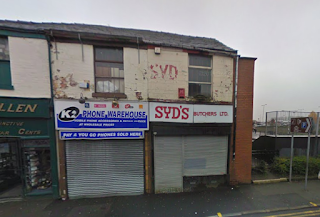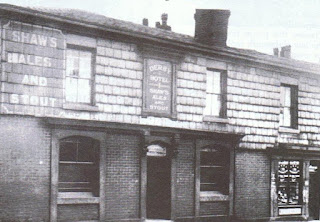In
his book Bolton Pubs 1800 – 2000, Gordon Readyhough claims the Ormrods Arms was
a former name for the Railway Hotel on Great Moor Street. That isn’t true.
The
1849 list of Great Bolton beerhouses has both an Ormrods Arms and a Railway
Tavern on Great Moor Street. Skip a few years and the 1853 Bolton Directory has
the Ormrods Arms at 32 Great Moor Street and the Railway at 38 Great Moor
Street so the two pubs were completely separate. In those days, streets weren’t numbered odds on one side and evens on
the other. Quite often buildings were numbered starting from number 1 on one
side up to the top of the street and then back down the other side of the
street. Problems arose when streets were extended so a convention was
established where odds were on one side – usually the left – and evens were on
the other side of the street.
The
Railway was later renumbered 63 Great Moor Street – it was numbered as such by
1871. If the Ormrods Arms was six doors down then it would have been renumbered
51 Great Moor Street.
But
the Ormrods Arms was only a shortlived pub. The first mention we have is on the
1848 Bolton Directory when Jane Thompson is the licensee. In 1841, Jane
Thompson was a shopkeeper along with her husband Michael on Great Moor Street
just up from Dawes Street. The business wasn’t operating as a beerhouse on the
1843 Directory but Michael Thompson died in 1844. Either that was just as the decision
had been made to sell beer at the shop or perhaps Jane Thompson converted the
shop into a pub.
The
pub’s name came from the nearby Flash Street Mills owned by Messrs Ormrod and
Hardcastle. James Ormrod and Thomas
Hardcastle began a textile business in 1798. James Ormrod died in 1825 and was succeeded
by his son Peter Ormrod. The family’s seat was Chamber Hall at the bottom of
Deane Road.
John
Wood was at the Ormrod’s Arms in 1851. He was initially a bleacher but got into
the pub trade. He was 56 by this time. He had moved to the Crown Inn on
Shipgates in 1861 and the Mill Hill Tavern on Mill Hill Street by 1871. His son
Thomas Wood worked at each pub as a brewer.
The
Ormrods Arms slips off the radar at this point. Number 51 Great Moor Street
certainly wasn’t a pub on any subsequent directory listings. It was a
tobacconist in 1905 and by 1924 it was a milliner.
But
the building still stands. Many readers will be familiar with its incarnation
as Syd’s Butchers which occupied the premises for many years. Syd’s (Butchers)
Ltd was formed as a limited company in 1947 and was finally dissolved in 1997.
But the premises remained empty for many years afterwards until the Scissor Art
hairdressing salon opened there in 2012.
The
former Ormrod’s Arms was Syd’s Butcher’s on this image from October 2009
(copyright Google Street View). The building was empty for almost 20 years
after Syd’s packed up and was even empty long after the business was liquidated.
Note the ‘ghost’ advertising in red at the top of the building.















